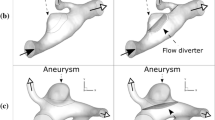Abstract
We present particle tracking velocimetry measurements and flow visualization of pulsatile flow fields in a stented cerebrovascular lateral aneurysm model with a wide ostium anchored on a curved parent vessel. Among the stent parameters, the blocking ratioC α ranging from 0% to 75% was selected to study its effect on the changes of intra-aneurysmal hemodynamics for the reference of minimally invasive endovascular aneurysm treatment. The Womersley number was 3.9 and the mean, peak, and minimal Reynolds numbers based on the bulk average velocity and diameter of the parent vessel were 600, 850, and 300, respectively. The results are characterized in terms of velocity vector field, coded streak images, region averaged velocity, vorticity, and wall shear stress. A critical range ofC α related to the inflow location as well as the shape and number of intra-aneurysmal vortices is identified. The intra-aneurysmal flow activity, vortex strength, and wall shear stress are found to decrease with increasingC α. Among theC α examined,C α=75% is the most favorable in attenuating the risk of aneurysmal rupture and promoting intra-aneurysmal thrombus.
Similar content being viewed by others
References
Dotter, C.T. andJudkins, M.P., “Transluminal Treatment of Arteriosclerotic Obstruction: Description of a New Technique and a Preliminary Report of its Application,”Circulation,30,654–670 (1964).
Black, S.P.W. andGerman, W.L., “Observation on the Relationship Between the Volume and the Size of the Orifice of Experimental Aneurysms,”Journal of Neurosurgery,17,984–990 (1960).
Ferguson, G.G., “Physical Factors in the Initiation, Growth, and Rupture of Human Intracranial Saccular Aneurysm,”Journal of Neurosurgery,37,666–677 (1972).
Roach, M., Scott, S., andFerguson, G.G., “The Hemodynamic Importance of Geometry of Bifurcations in the Circle of Willis (Glass Model Studies),”Stroke,3,255–267 (1972).
Niimi, H., Kawano, Y., andSugiyama, I., “Structure of Blood Flow Through a Curved Vessel with an Aneurysm,”Biorheology,21,603–615 (1984).
Liepsch, D.W., Steiger, H.J., Poll, A., andReulen, H.J., “Hemodynamic Stress in Lateral Saccular Aneurysms,”Biorheology,24,689–710 (1987).
Liou, T.M., Chang, W.C., andLiao, C.C., “LDV Measurements in Lateral Model Aneurysms of Various Sizes,”Experiments in Fluids,23, (4),317–324 (1997).
Liou, T.M. andLiao, C.C., “Flowfields in Lateral Aneurysm Models Arising from Parent Vessels with Different Curvatures Using PTV,”Experiments in Fluids,23 (4),288–298 (1997).
Burleson, A.C., Strother, C.M., andTuritto, V.T., “Computer Modeling of Intracranial Saccular and Lateral Aneurysms for the Study of their Hemodynamics,”Journal of Neurosurgery,37,774–784 (1995).
Löw, M., Perktold, K., andRauning, R., “Hemodynamics in Rigid and Distensible Saccular Aneurysms: a Numerical Study of Pulsatile Flow Characteristics,”Biorheology,30,287–298 (1993).
Aenis, M., Stancampiano, A.P., Wakhloo, A.K. andLieber, B.B., “Modelling of Flow in a Straight Stented and Non-Stented Side Wall Aneurysm Model,”ASME Journal of Biomechanical Engineering,119,206–212 (1997).
Lieber, B.B., Livescu, V., Hopkins, L.N., andWakhloo, A.K., “Particle Image Velocimetry Assessment of Stent Design Influence on Intra-Aneurysmal Flow,”Annals of Biomedical Engineering,30,768–777 (2002).
Marks, M.P., Dake, M.D., Steinberg, G.K., Norbash, A.M.,andLane, B. “Stent Placement for Arterial and Venous Cerebrovascular Disease: Preliminary Clinical Experience,”Radiology,191,441–446 (1994).
Wakhloo, A.K., Schellhammer, F., Vries, J.D., Haberstroh, J., andSchumacher, M., “Self-Expanding and Balloon-Expandable Stents in the Treatment of Carotid Aneurysms: An Experimental Study in a Canine Model,”AJNR: American Journal of Neurosurgery.15,493–502 (1994).
Liou, T.M. andLiao, C.C., “Study of Pulsatile Flows in Lateral Aneurysm Models on a Straight Parent Vessel Using Particle Tracking Velocimetry,”Journal of Flow Visualization and Image Processing,3 (3),207–223 (1996).
Nichols, W., andO'Rourke, M., McDonald's Blood Flow in Arteries, Lea & Febiger, Philadelphia, PA (1990).
Gobin, Y.P., Counord, J.L., Flaud, P., andDuffaux, J., “In Vitro Study of Haemodynamics in a Giant Saccular Aneurysm Model: Influence of Flow Dynamics in the Parent Vessel and Effects of Coil Embolisation,”Neuroradiology,36,530–536 (1994).
Crawford, T., “Some Observations of the Pathogenesis and Natural History of Intracranial Aneurysms,”Journal of Neurology, Neurosurgery and Psychiatry,22,259–266 (1959).
Fry, D.L., “Acute Vascular Endothelial Changes Associated with Increased Blood Velocity Gradients,”Circulation Research22,165–197 (1968).
Fry, D.L., “Certain Histological and Chemical Responses of the Vascular Interface to Acutely Induced Mechanical Stress in the Aorta of the Dog,”Circulation Research,14,93–108 (1969).
Author information
Authors and Affiliations
Rights and permissions
About this article
Cite this article
Liou, T.M., Liou, S.N. Pulsatile flows in a lateral aneurysm anchored on a stented and curved parent vessel. Experimental Mechanics 44, 253–260 (2004). https://doi.org/10.1007/BF02427891
Received:
Revised:
Issue Date:
DOI: https://doi.org/10.1007/BF02427891




